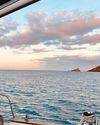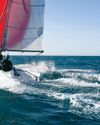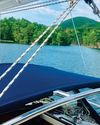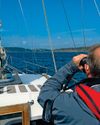
The life of a radar on board a cruising yacht is an easy one. Aside from a few hours of action when it’s misty or foggy, its younger sibling, AIS, does the heavy lifting of collision avoidance for most yachts. Once the preserve of large yachts and commercial vessels, however, radar is increasingly found on yachts under 40ft. It’s become more affordable, easier to install and more intuitive to use, but how about its operators? Have we advanced with it and are we using it to its full potential? I suspect not.
Like many cruising boats, the Challenge 72 that I co-skipper, CatZero, constantly receives and transmits AIS data. Since it runs in the background the volunteer watch leaders soon become familiar with it. The all-new B&G Halo 24 radar is turned off until needed. I took the opportunity of a light airs delivery from Cherbourg to Portsmouth after the Fastnet Race to introduce the crew to the new tool, and become better acquainted with the latest technology myself.
HOW IT WORKS
With radar, more than any other equipment, it’s important to understand how it works – what it can do and, more crucially, what it can’t. Radar stands for RAdio Detection And Ranging. It works by emitting a powerful radio wave and then listening for the echo as the signal bounces off objects in range. By timing how long the echo takes to return it can calculate distance with precision. Angles are harder to differentiate: the beam width of a traditional radar is 3-4° wide, which makes bearings less accurate than range.
Denne historien er fra January 2024-utgaven av Yachting Monthly UK.
Start din 7-dagers gratis prøveperiode på Magzter GOLD for å få tilgang til tusenvis av utvalgte premiumhistorier og 9000+ magasiner og aviser.
Allerede abonnent ? Logg på
Denne historien er fra January 2024-utgaven av Yachting Monthly UK.
Start din 7-dagers gratis prøveperiode på Magzter GOLD for å få tilgang til tusenvis av utvalgte premiumhistorier og 9000+ magasiner og aviser.
Allerede abonnent? Logg på

Midsummer on Hanö
This wonderful little island in the south-east of Sweden is a real gem off the beaten track

ADVENTURE SAILING TO HAITI
After spending two months in the Dominican Republic, Andy Brown sails west to Haïti bringing medical and school supplies to the town of Mole Saint Nicholas

In celebration of bad sailing
New owner Monty Halls tests his sailing skills with his family aboard their Colvic 34 ketch, Sobek. A recently qualified Day Skipper, Monty faces a few unexpected challenges...

Winter brings excitement and opportunity
Oddity’s double glazing, insulation and heating create a warm, homely environment as I bash out this column.

ADVENTURE MAISIE GOES TO GOES
To depart or not to depart? That is the question. Is it safer to stay, or suffer the wind and weather of a rough North Sea?

'MAYDAY, GRANDAD OVERBOARD!'
When David Richards and his grandson Henry went out racing from lowey, they didn't expect their sail to end with a lifeboat rescue

VERTUE
For a 25-footer, the Vertue has a huge reputation and has conquered every ocean. So what makes this little boat quite such an enduring success? Nic Compton finds out

Sailing siblings
Mabel Stock, her brother Ralph, a friend Steve and an unnamed paying passenger passed through the Panama Canal in December 1919 on the sturdy Norwegian cutter Ogre. They were towed to a quiet anchorage in Balboa away from the boat traffic but within rowing distance of the shore.

TECHNICAL MAINSAIL MODIFICATIONS
Safety and performance improved hugely when Mike Reynolds reduced the size of his mainsail and re-configured the systems controlling it

PILOTAGE DONE PROPERLY
Chartplotters are an amazing aid, but can detract from your real-world pilotage if not used with caution, says Justin Morton